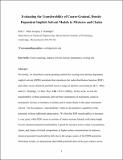Evaluating the transferability of coarse-grained, density-dependent implicit solvent models to mixtures and chains
Author(s)
Allen, Erik C.; Rutledge, Gregory C.
DownloadA809082rev_ms.pdf (2.920Mb)
OPEN_ACCESS_POLICY
Open Access Policy
Creative Commons Attribution-Noncommercial-Share Alike
Terms of use
Metadata
Show full item recordAbstract
Previously, we described a coarse-graining method for creating local density-dependent implicit solvent (DDIS) potentials that reproduce the radial distribution function (RDF) and solute excess chemical potential across a range of particle concentrations [ E. C. Allen and G. C. Rutledge, J. Chem. Phys. 128, 154115 (2008) ]. In this work, we test the transferability of these potentials, derived from simulations of monomeric solute in monomeric solvent, to mixtures of solutes and to solute chains in the same monomeric solvent. For this purpose, “transferability” refers to the predictive capability of the potentials without additional optimization. We find that RDF transferability to mixtures is very good, while RDF errors in systems of chains increase linearly with chain length. Excess chemical potential transferability is good for mixtures at low solute concentration, chains, and chains of mixed composition; at higher solute concentrations in mixtures, chemical potential transferability fails due to the nature of the DDIS potentials, in which particle insertion directly affects the interaction potential. With these results, we demonstrate that DDIS potentials derived for pure solutes can be used effectively in the study of many important systems including those involving mixtures, chains, and chains of mixed composition in monomeric solvent.
Date issued
2009-01Department
Massachusetts Institute of Technology. Department of Chemical EngineeringJournal
Journal of Chemical Physics
Publisher
American Institute of Physics
Citation
Allen, Erik C., and Gregory C. Rutledge. “Evaluating the transferability of coarse-grained, density-dependent implicit solvent models to mixtures and chains.” The Journal of Chemical Physics 130.3 (2009): 034904.
Version: Author's final manuscript
ISSN
0021-9606